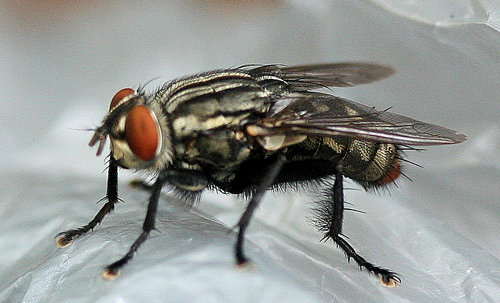Have you ever been to a butcher shop and found lots of small black, red eyed flies? Well if yes, then you must stop buying meat from that shop as it means that the shop has been infested by flesh flies.
Flesh flies usually thrive on dead animals, human and animal excreta. They don’t bite but they are harmful as they carry leprosy bacilli and can also cause intestinal infections if you consume the meat that they have infected. In this article we will see how to get rid of flesh flies:
Table Of Contents
Identifying a Flesh Fly
Physical Features
Flesh flies are remarkably large flies with three black stripes on their thorax. They have thick gray bodies. They have bright red eyes which makes them easier to identify. They usually are 10 to 13 mm long.
The males are hairier when compared to female flesh flies and have more strong front legs. Adult flesh flies also have a black strip with golden or yellowish margins between their eyes.
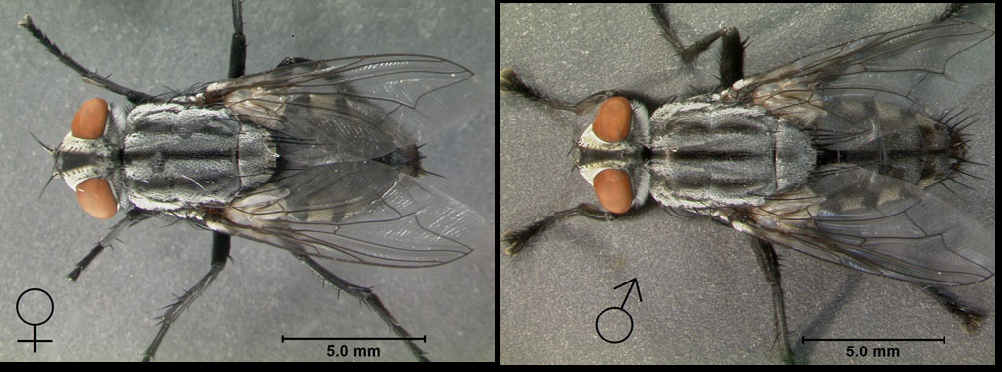
The flesh fly pupa usually ranges between 5 to 10 mm. The darker the color of pupa the more advanced the fly is in pupa development.
The larvae of flesh flies are white or yellow maggots with pointed heads. They could grow 10 to 13 mm. The stages of the flesh fly’s lifecycle are a key during forensic investigations as this tells how old the dead body of an animal or human being is.
Behavior and Habitat
Flesh flies occur both in urban and rural areas but fortunately are relatively uncommon in houses or restaurants, unless there is a breeding site at these places. Flesh flies breed on human or animal feces, decaying vegetables or meat, carrion, animal flesh.
Flesh flies are attracted to dead animals, feces, exposed trash and decaying vegetables. Flesh flies usually breed across below areas:
- Dead Animals or carcass of dead animals \ rodents
- Pet feces accumulated in outdoor
- Decaying vegetables
- Poorly maintained composite bins
- Open garbage bags or trash cans
Life Cycle of a Flesh Fly
Flesh flies are very similar to other species of flies when we compare their lifecycle. It consists of 4 life stages – egg, larva, pupa and adult. The entire lifecycle is 23 days long. The only difference being that the flesh fly’s eggs incubate, develop, and hatch within the adult female’s body rather than on or near carcasses and other external food sources.
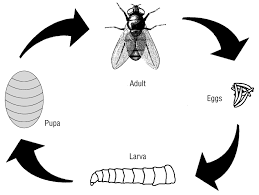
After eggs hatch female adult flies deposit the larvae as maggots on carcasses, dead animals, or shallow buried carcasses. Larvae prefer moist temperature and takes seven to nine days before pupating. On the other hand, pupae prefer cool temperatures and develop quickly. On an average most flesh flies take 2 – 9 days to emerge as an adult from larva.
Damages
Flesh flies do not bite but that does not make them less hazardous. Since they breed on meat hence they easily infest it. Anyone who consumes the infested meat is much likely to fall sick due to intestinal infections.
Flesh flies carry leprosy bacilli and can transmit leprosy. They can also transmit other diseases like polio. Hence they are very harmful and must be eradicated as soon as there is an infestation.
How to Get Rid of Flesh Flies
The process of getting rid of flesh flies can be divided into two stages:
Stage 1 (Flesh Fly Control Techniques) – Stage 1 primarily comprises of the methods that can be used to control the further growth of flesh flies. Here we try to control the growth of flies by cleaning or rather destroying their breeding sources. This will help to stop any further growth of the flies.
Stage 2 (Flesh Fly Elimination Techniques) – After we have cleaned all the possible breeding sites of the flesh flies, we will be left only with the adult flies. Since they now have no place to lay eggs, so the flesh fly problem will come to an end after the adult flies are killed. And this is the Stage 2 of the process.
Recommended Reading: How to get rid of house flies
Stage 1: Flesh Fly Control Techniques
Once a home or shop or restaurant gets infested with flesh flies, all the probable breeding sites must be located and cleaned. Unless the breeding sites are identified and cleaned, the flesh fly infestation will continue no matter how many insecticidal fogs or sprays are used.
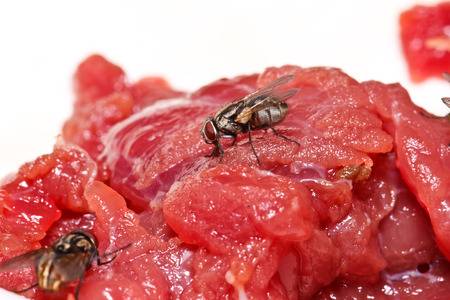
Step 1: Find the Breeding Place
Finding the breeding spot is the most important step in the Stage 1 of the process. Sometimes it can be very challenging and will often require a good amount of thought and determination. In case of flesh flies once you find the breeding spot you have won the half of the battle, as this will stop the infestation.
Following is a list of common flesh fly breeding sites:
- Cracks between walls where dead birds can get stuck
- If you have a pet, then do check underneath furniture and other electronic appliances as sometimes our flurry friends bring us some nasty surprises
- Garbage bins or trash cans where you usually dispose animal waste or diapers
- Pet feces accumulated in open or dung
- Decaying vegetable matter
- Shallow buried carcass
Step 2: Clean the Breeding Source
After you have found a possible breeding source of flesh flies, remove the breeding source if it’s some dead animal, carcass, etc. by wrapping it in a plastic bag and seal it up and throw it in the trash can. You can also burn or bury it. Wash the breeding site with borax and water solution. After washing the site, try to keep the area clean and dry.
Also ensure to dispose any waste matter in air tight plastic bags only, to prevent the infestation from reoccurring.
Stage 2: Flesh Fly Elimination Techniques
Usually after removing the breeding source flesh flies are eliminated. In stage 2 of the process, we are going to have a look at some methods to kill or trap the adult flesh flies in the infested areas. In this section, we are going to see some quick fire ways to eradicate flesh flies:
Recommended Reading: How to get rid of horse flies
Disposable Fly Traps:
Disposable fly traps are one of the best fly catchers. They provide a simple, no-mess way to keep flies away from your patio and garden.
A disposable fly trap consists of a specially formulated bait or attractant which is water soluble. The attractant is kept inside a pouch and only gets activated when you add water to it.
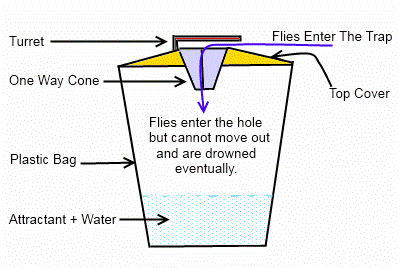
After adding water to it, the attractant dissolves in the water producing a sweet smell which flies love. Flies can get inside the bag, but due to its construction they are not able to move out and eventually are drowned in the water inside.
These kinds of traps have been proved to work against multiple types of flies like: House flies, blow flies, carrion flies, cluster flies, flesh flies, stable flies etc.
Recommended Reading: Homemade fly trap
Can be used both indoors and outdoors
Simple, no-mess way to get rid of flies
Works against most species of flies
You may need to keep them away from babies and pets, as the attractants may be toxic
Citronella or Camphor Repellent:
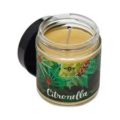 Citronella and Camphor both are very good at repelling flesh flies. In general flesh flies hate smoke, but when the smoke is from a citronella candle or a piece of camphor then it becomes doubly effective against them.
Citronella and Camphor both are very good at repelling flesh flies. In general flesh flies hate smoke, but when the smoke is from a citronella candle or a piece of camphor then it becomes doubly effective against them.
To try this method, light a citronella candle or a piece of camphor and spread the smoke in the fly infested area and you could see them leaving the place instantly.
No chemicals
Works great against all species of flies
Produces smoke and hence may aggravate breathing disorders
Using a Fly Vacuum:
A fly vacuum is a type of small but powerful portable vacuum cleaner that runs on electricity. You only have to switch on the device and point in the direction of flies to catch them.

Some variants of bug vacuum also have a trap door that securely traps the, insects within the nozzle and prevents them from flying back out. With some practice you can become a pro fly catcher with your portable vacuum.
No chemicals
Easy to use
Fly vacuums are a bit pricey
Using an Electronic Portable FlySwatter:
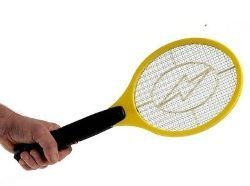 Electronic portable Flyswatters are also called fly bats as they resemble badminton rackets. These swatters have an ON/OFF switch near the handle. By switching it ‘ON’, the swatter gets charged to a voltage of between 1000 and 2500 V DC.
Electronic portable Flyswatters are also called fly bats as they resemble badminton rackets. These swatters have an ON/OFF switch near the handle. By switching it ‘ON’, the swatter gets charged to a voltage of between 1000 and 2500 V DC.
For killing the fly, you have to swing the bat in the direction of the fly. When fly comes near the electrodes (charged grid), a spark jumps through the fly and it gets killed.
The best thing about such fly swatters is that, you don’t have to wait for the flies to land anymore; you can just kill these pests right out of thin air.
Portable
Highly effective insect killer
Long lasting, Water and dust proof
Made from UV-resistant ABS plastic
Difficult to run after the flies to kill them
Using Chemical Fly Sprays:
There are some chemical sprays in market (like: HotShot or RAID Insect killers) that can kill flies instantly. These sprays usually have a quick response time and hence are preferred by many people.
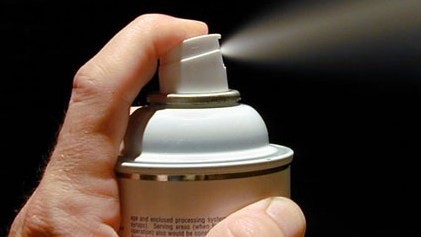
Few of such sprays are pet safe and some are even safe to be used on plants. Regular repeated application for 1 or 2 weeks can give long lasting results. These kinds of sprays work like a charm against flesh flies.
The only thing that goes against them is that most of such fly sprays are toxic and sometimes can have a bad impact on the environment.
Shows effect pretty fast
Works against multiple species of flies
Easy to use
Toxic and Bad for Environment
How to Prevent Flesh Flies?
It is said prevention is better than cure. So, here are a few tips that can help you to prevent a flesh fly invasion in your home:
- If you have pets, then keep a check if they are bringing any dead animals inside the house
- Fill any cracks in the walls so that dead animals don’t get stuck
- Cover your garbage cans and dispose of the garbage at least thrice a week
- Dispose pet feces in an air tight plastic bag if you don’t dump it in compost pits
- Keep compost pits covered
- If you have buried any dead animals, they bury them deeper and not shallow
- Keep an eye on the wounds of your pets and clean them regularly
So, this was all about how to get rid of flesh flies. We would love to hear if you have some other methods, stories or ideas related to the topic.
Good luck, soldier! 🙂
